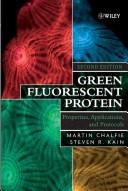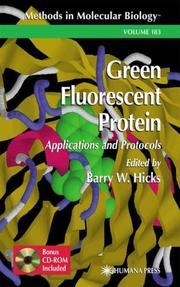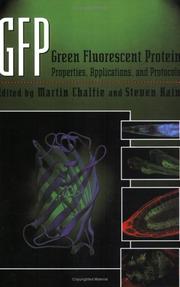| Listing 1 - 6 of 6 |
Sort by
|
Book
ISBN: 9780199362820 0199362823 9780199362813 0199362815 0199362831 Year: 2015 Publisher: Oxford, [England] ; New York, New York : Oxford University Press,
Abstract | Keywords | Export | Availability | Bookmark
 Loading...
Loading...Choose an application
- Reference Manager
- EndNote
- RefWorks (Direct export to RefWorks)
Since scientists began experimenting with green fluorescent proteins in the middle of the 1990s, these proteins have become one of the most important tools available to researchers in modern medicine and biology. By using them to illuminate other proteins that were previously invisible even under microscope, scientists are now able to observe facets of disease that would have otherwise gone undetected. Green fluorescent proteins are a part of over three million experiments a year, and are invaluable for tasks such as tracking HIV, breeding bird flu-resistant chickens, and confirming the existe
Green fluorescent protein. --- GFP (Protein) --- Green jellyfish protein --- Fluorescent polymers --- Proteins

ISBN: 0471453285 0471736821 9780471736820 9780471453284 Year: 2006 Volume: 47 Publisher: Hoboken (N.J.): Wiley,
Abstract | Keywords | Export | Availability | Bookmark
 Loading...
Loading...Choose an application
- Reference Manager
- EndNote
- RefWorks (Direct export to RefWorks)

ISBN: 0896039056 9786610830657 1280830654 1592592805 Year: 2002 Volume: 183 Publisher: Totowa (N.J.) : Humana press,
Abstract | Keywords | Export | Availability | Bookmark
 Loading...
Loading...Choose an application
- Reference Manager
- EndNote
- RefWorks (Direct export to RefWorks)
Barry W. Hicks and a team of well-practiced experimentalists demonstrate the power and the versatility of the green fluorescent protein (GFP) marker with a cutting-edge collection of readily reproducible GFP techniques. These include methods for detecting and imaging GFP (FRET, BRET, and whole-body imaging); for using GFP to create and select for transgenic organisms, for its use as a biosensor; and for studying viruses. A valuable companion CD-ROM displays many color figures and videos from over half the chapters.
Analytical biochemistry --- Green fluorescent protein --- Protéine fluorescente verte --- Laboratory manuals. --- Manuels de laboratoire --- GFP (Protein) --- Green jellyfish protein --- Fluorescent polymers --- Proteins --- Cytology. --- Cell Biology. --- Cell biology --- Cellular biology --- Biology --- Cells --- Cytologists

ISBN: 047117839X 9780471178392 Year: 1998 Publisher: New York (N.Y.) : Wiley-Liss,
Abstract | Keywords | Export | Availability | Bookmark
 Loading...
Loading...Choose an application
- Reference Manager
- EndNote
- RefWorks (Direct export to RefWorks)
Analytical biochemistry --- Green fluorescent protein --- Zooplancton --- Zooplankton --- Protéine --- proteins --- Fluorescence --- Aequorea aequorea --- 577.112 --- 591.148 --- 58.035 --- #WSCH:MODS --- GFP (Protein) --- Green jellyfish protein --- Fluorescent polymers --- Proteins --- Luminescence (bioluminescence) --- Emitted and absorbed light. Luminescence (bioluminescence) --- Green fluorescent protein. --- 58.035 Emitted and absorbed light. Luminescence (bioluminescence) --- 591.148 Luminescence (bioluminescence) --- 577.112 Proteins --- Zooplankton. --- Jellyfish --- Meduse
Book
ISBN: 1283948346 1606504177 9781606504178 1606504274 9781606504277 9781606504277 9781283948340 Year: 2013 Publisher: New York, N.Y. New York, N.Y. (222 East 46th Street, New York, NY 10017) ASME Momentum Press
Abstract | Keywords | Export | Availability | Bookmark
 Loading...
Loading...Choose an application
- Reference Manager
- EndNote
- RefWorks (Direct export to RefWorks)
Two strategies are usually considered for the optimization of microbial bioprocesses. The first one involves genetic or metabolic engineering of the target microbial strains in order to improve its production efficiency or its tolerance to adverse conditions. The second one is based on the chemical engineering improvement of the bioreactors and scaling-up rules. This work is more particularly dedicated to this second class of parameters.
Microbial biotechnology. --- Green fluorescent protein. --- Biosensors. --- Biodetectors --- Biological detectors --- Biological sensors --- Biomedical detectors --- Biomedical sensors --- Detectors --- Medical instruments and apparatus --- Physiological apparatus --- GFP (Protein) --- Green jellyfish protein --- Fluorescent polymers --- Proteins --- Microorganisms --- Biotechnology --- Industrial microbiology --- Biotechnological microorganisms --- biomedical and nanomedical technologies --- engineering --- microbial cells
Book
ISBN: 3642233767 3642446825 1280396067 9786613573988 3642233775 Year: 2012 Publisher: Berlin : Springer,
Abstract | Keywords | Export | Availability | Bookmark
 Loading...
Loading...Choose an application
- Reference Manager
- EndNote
- RefWorks (Direct export to RefWorks)
Fluorescent proteins are intimately connected to research in the life sciences. Tagging of gene products with fluorescent proteins has revolutionized all areas of biosciences, ranging from fundamental biochemistry to clinical oncology, to environmental research. The discovery of the Green Fluorescent Protein, its first, seminal application and the ingenious development of a broad palette of fluorescence proteins of other colours, was consequently recognised with the Nobel Prize for Chemistry in 2008. Fluorescent Proteins II highlights the physicochemical and biophysical aspects of fluorescent protein technology beyond imaging. It is tailored to meet the needs of physicists, chemists and biologists who are interested in the fundamental properties of fluorescent proteins, while also focussing on specific applications. The implementations described are cutting-edge studies and exemplify how the physical and chemical properties of fluorescent proteins can stimulate novel findings in life sciences.
Biofluorescence. --- Fluorescent polymers. --- Chemistry --- Physical Sciences & Mathematics --- Analytical Chemistry --- Organic Chemistry --- Green fluorescent protein. --- GFP (Protein) --- Green jellyfish protein --- Chemistry. --- Molecular biology. --- Analytical chemistry. --- Medical biochemistry. --- Cell biology. --- Biology --- Biophysics. --- Biological physics. --- Analytical Chemistry. --- Molecular Medicine. --- Medical Biochemistry. --- Biophysics and Biological Physics. --- Cell Biology. --- Biological Techniques. --- Technique. --- Biological physics --- Medical sciences --- Physics --- Cell biology --- Cellular biology --- Cells --- Cytologists --- Medical biochemistry --- Pathobiochemistry --- Pathological biochemistry --- Biochemistry --- Pathology --- Analysis, Chemical --- Analytical chemistry --- Chemical analysis --- Metallurgical analysis --- Mineralogy, Determinative --- Molecular biochemistry --- Molecular biophysics --- Biophysics --- Biomolecules --- Systems biology --- Physical sciences --- Fluorescent polymers --- Proteins --- Bioluminescence --- Fluorescence --- Polymers --- Analytical biochemistry. --- Medicine. --- Biochemistry. --- Cytology. --- Cytology --- Biological and Medical Physics, Biophysics. --- Research --- Methodology. --- Clinical sciences --- Medical profession --- Human biology --- Life sciences --- Physicians --- Analytic biochemistry --- Chemistry, Analytic --- Biological chemistry --- Chemical composition of organisms --- Organisms --- Physiological chemistry --- Composition --- Health Workforce --- Bioanalytic chemistry --- Bioanalytical chemistry --- Biology—Technique. --- Analytic chemistry
| Listing 1 - 6 of 6 |
Sort by
|

 Search
Search Feedback
Feedback About UniCat
About UniCat  Help
Help News
News